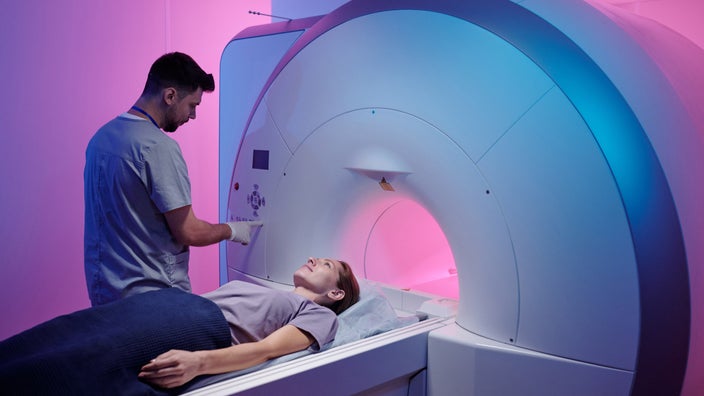
How Much Does an MRI Cost?
Key takeaways:
Magnetic resonance imaging (MRI) is a medical scan that produces detailed pictures of areas inside the body to help diagnose conditions.
An MRI can cost anywhere from $400 to $12,000, depending on the provider, health insurance, location, extra medications, and body part scanned.
Health insurance typically covers authorized MRIs. But you may encounter out-of-pocket costs, such as deductibles, copays, or coinsurance.
Table of contents

If you have an unexplained pain or internal injury, your healthcare professional may want to order a magnetic resonance imaging (MRI) scan. Unlike other X-rays or scans that use radiation, an MRI can be a safer option because it uses radio waves and magnets to produce detailed 3D images inside your body. That’s why nearly 40 million MRIs are performed every year. Although they are useful to help detect and diagnose conditions or monitor treatments, MRIs are often not cost-effective.
Many factors can affect the price of an MRI, and it’s not always easy to determine the exact cost up front. But knowing what to expect can help you avoid surprises and unnecessary expenses.
What is the average cost of an MRI?
On average, MRIs in the U.S. can cost $400 to $12,000. The national average is $1,325, but one report shows that the target “fair price” is $750. The actual price you pay depends on your body area being scanned, location, and other factors.
SHINGRIX (Zoster Vaccine Recombinant, Adjuvanted) is now $0 for almost everyone*
Get SHINGRIX at the pharmacy or in-network doctor’s office today. 98% of privately insured people pay $0 and all Medicare Part D beneficiaries pay $0 at the pharmacy.
Prescribing Information
*Coverage and cost may vary and are subject to change without notice. Reimbursement decisions are made by individual insurance plans.


SHINGRIX is an FDA-approved vaccine for the prevention of shingles (herpes zoster) in adults 50 years and older. SHINGRIX is not used to prevent chickenpox.
• You should not receive SHINGRIX if you are allergic to any of its ingredients or had an allergic reaction to a previous dose of SHINGRIX
• An increased risk of Guillain-Barré syndrome (severe muscle weakness) was observed after vaccination with SHINGRIX
• Fainting can happen after getting injectable vaccines, including SHINGRIX. Precautions should be taken to avoid falling and injury due to fainting
• The most common side effects are pain, redness, and swelling at the injection site, muscle pain, tiredness, headache, shivering, fever, and upset stomach
• SHINGRIX was not studied in pregnant or nursing women. Tell your healthcare provider if you are pregnant, plan to become pregnant, or are breastfeeding
• Vaccination with SHINGRIX may not protect all individuals
• Ask your healthcare provider about the risks and benefits of SHINGRIX. Only a healthcare provider can decide if SHINGRIX is right for you
You are encouraged to report vaccine adverse events to the US Department of Health and Human Services. Visit www.vaers.hhs.gov to file a report, or call 1-800-822-7967.
For US audiences.
Trademarks are property of their respective owners.
©️2024 GSK or licensor.
PMUS-SGXWCNT240015 May 2024
Produced in the USA.
GoodRx Health information and resources are reviewed by our editorial staff with medical and healthcare policy and pricing experience. See our editorial policy for more detail. We also provide access to services offered by GoodRx and our partners when we think these services might be useful to our visitors. We may receive compensation when a user decides to leverage these services, but making them available does not influence the medical content our editorial staff provides.
An MRI can be used from head to toe, and prices can rise significantly depending on the area being scanned. Some body parts that are candidates for an MRI include:
Abdomen
Arm
Brain
Breasts
Bones
Hip
Joints
Knee
Leg
Pelvis
Shoulder
Spinal cord
Below are a few examples from a healthcare marketplace of MRI costs based on the body part.
MRI procedure | Average cost |
|---|---|
Bone | $410-$2,100 |
Brain | $1,600-$8,400 |
Cervical spine | $1,400-$7,600 |
Chest | $500-$7,900 |
Pelvic MRI | $500-$7,900 |
Keep in mind that costs can increase if medication is needed. For instance, the average cost of an MRI may increase if you require oral sedatives, intravenous (IV) conscious sedation, or general anesthesia. Oral sedatives require the least monitoring. An IV sedative needs to be administered by a nurse. Higher-dose IV sedatives and anesthesia need to be monitored by an anesthesiologist. Each level of monitoring increases the expense.
If your doctor recommends an MRI, contact your insurance provider regarding your benefits so you won’t be faced with surprise bills later.
Comparing imaging tests: CT scans and MRIs are both used to take a closer look inside the body. Learn more about the differences between the tests, including the pros and cons of each.
Sizing up CT costs: Your medical team may recommend a CT scan before considering an MRI. Here’s how much you might pay for that test.
Managing medical bills: Find out how one person was able to get help with medical bills by working with a debt advocate.
What factors affect the cost of an MRI?
Several factors can affect the cost you will pay for an MRI, including:
Type of health insurance: Depending on your insurance coverage, the cost of an MRI can vary from a copay to a percentage of the bill.
In-network versus out-of-network providers: Providers in your network must charge the contracted rate that was negotiated with the insurance company. This rate is typically much lower than the out-of-network or out-of-pocket costs you would pay without insurance.
Type of scan: Doing an open MRI costs less than a traditional or closed MRI scan. An MRI scan with contrast also costs more.
Body area being scanned: MRI prices can also vary based on body parts. For example, a brain scan may cost more than a knee scan, since it requires a more detailed analysis from a specialized doctor.
Place of service (inpatient versus outpatient): The location can affect cost. Having your scan at a freestanding MRI center usually costs less than a scan at a hospital because freestanding centers are less expensive to run.
Region of the country: Your city, state, or area of the country may affect MRI costs.
Sedatives: Claustrophobic people may need a sedative, which can add extra medication costs. The type of sedation required (oral, IV conscious sedation, or general anesthesia) will affect the costs. Ativan, Valium, and Xanax are common sedatives that your prescriber may recommend to reduce your pain and anxiety during an MRI.
Radiologist reading: There may be a charge for a radiologist to review and interpret your results.
How much does an MRI cost without insurance?
One of the most significant factors affecting your MRI cost is whether you have insurance. People who do not have health insurance will pay the total cost of the MRI.
Check with your healthcare professional’s office about the following financial options to help reduce your up-front costs:
Assistance programs
Discounts
Medical payment plans
After an MRI, you may receive two separate bills: one from the facility and another from the radiologist. Billing will depend on your healthcare professional and the location you choose for your services. MRIs at emergency rooms often cost more than in other locations. For instance, an MRI could cost $4,000 at a hospital ER but only $400 at an imaging center.
Read more like this
Explore these related articles, suggested for readers like you.
To help reduce your costs, ask your doctor about the following options:
An imaging center
A walk-in clinic
An urgent care
These options tend to be the most affordable. But do your research and ask the right questions to ensure you get the care you need.
The American College of Radiology offers a search tool to help you find imaging facilities in your area. Radiology Assist — a national program that gives underinsured individuals access to affordable MRIs and other imaging procedures — notes that a person without insurance should expect to pay about $2,000 for an MRI.
Does health insurance cover the full cost of an MRI?
Imaging tests like MRIs are generally covered in some part by health insurance. Contact your insurance provider to determine if MRIs are covered under your health plan and the coverage amount. You may still encounter out-of-pocket expenses, but health plans might cover 100% of your MRI costs, depending on your employer.
For example, the New York Health Benefits program offers several plans that cover authorized MRIs at no charge. It is also important to ask if your health plan requires a referral for an MRI or if preauthorization is necessary.
What can you expect to pay out of pocket for an MRI?
Even with insurance, you may need to meet a deductible before the insurance pays toward the cost of an MRI. You may also be responsible for other costs, such as a copay (flat fee) or coinsurance (your percentage after insurance pays).
If you have concerns about these costs, ask your healthcare professional about other diagnostic options. Additionally, using a health reimbursement arrangement, health savings account, or flexible savings account may reduce your out-of-pocket MRI expenses.
Does Medicare cover MRIs?
In general, Medicare Part B covers 80% of authorized tests, including MRIs. But you may still have out-of-pocket expenses, such as a copay, coinsurance, or deductible. Some health insurance companies offer Medicare Advantage plans that pay 100% for all covered services, including MRIs.
Even though Medicare may cover your MRI, you should be aware of the requirements. For example, MRIs must be:
Ordered by a Medicare-approved doctor
Performed at a facility that accepts Medicare
If contrast is used, how does it affect the cost of an MRI?
Contrast is a special dye used to enhance the MRI image. Your physician may order an MRI with contrast to get a better picture of any abnormalities in your body. Adding dye can increase the cost of your MRI by $110 to $310.
The bottom line
The total cost of an MRI depends on many factors, including health insurance, radiologist fees, and type of scan. Even with insurance, you should still expect some out-of-pocket expenses, such as deductibles, copays, and coinsurance.
On average, an MRI costs $400 to $12,000. You may want to ask your healthcare professional about assistance programs. You can also opt for less expensive testing alternatives if appropriate.
Why trust our experts?



References
American College of Radiology. (n.d.). Accredited facility search.
American Society of Neuroradiology. (n.d.). Magnetic resonance imaging.
DelPizzo, K. (2021). MRI with anesthesia: What to expect. Hospital for Special Surgery.
Health Images. (n.d.). Open MRI vs. closed MRI.
Ladapo, J. A., et al. (2018). Economics of MRI operations after implementation of interpersonal skills training. Journal of the American College of Radiology.
Medicare.gov. (n.d.). Diagnostic non-laboratory tests.
Medicare.gov. (n.d.). What Part B covers.
New York City Office of Labor Relations Health Benefits Program. (2024). Section IX – summary program description.
Radiology Assist. (n.d.). Nationwide MRI Program.
RadiologyInfo.org. (2023). Medical imaging costs.
Schmidt, G., et al. (2010). The uses and limitations of whole-body magnetic resonance imaging. Deutsches Ärzteblatt International.
Shah, A., et al. (2023). A review of magnetic resonance (MR) safety: The essentials to patient safety. Cureus.
The Pricer. (n.d.). Who are we?
Vanvuren, C. (n.d.). What can affect the cost of an MRI? New Choice Health.



























